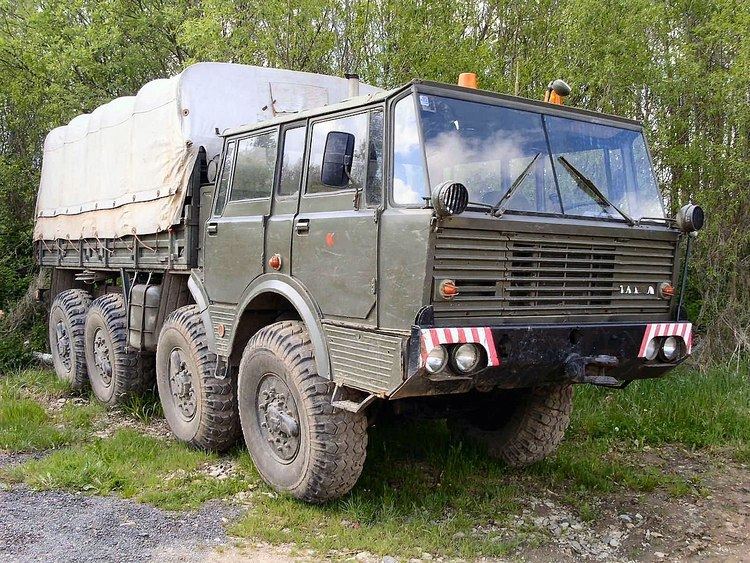Production 1967-1982 Body style COE | ||
 | ||
Length 8,800 mm (346.5 in) (T813 KOLOS) | ||
Tatra T813 was a truck produced in Czechoslovakia by the Tatra company. It was produced from 1959 to 1982. The basic representative of this series was the a military version of the 8 × 8 Kolos (Colossus), which was able to pull trailers up to a total weight of 100 tons. Tatra also produced a civilian version in either 6×6 or 4×4. After fifteen years of production 11,751 vehicles were built in all modifications, most of which were exported - mainly to the USSR , East Germany , Romania and India .
Contents
History
The first prototype already built in 1960 utilized existing Tatra T138 assemblies in 4x4 full-time all-wheel drive, which was also another first for Tatra. After the initial trials however the designers decided to develop and expand the concepts onto 8x8 all-wheel-drive all-terrain vehicle. The basis of the design thus became the modular chassis of T813. Successor is the Tatra T815 model.
Design and technology
The tubular backbone construction was once again selected. The main advantages of central load carrying backbone tube are in its high torsional and bending stiffness protecting the truck's body against load stresses. Another advantage is that it houses all important parts of the drive train as well as it enables a concept of modular construction where designers and customers can specify 4,6,8, wheel drive and various length wheelbase combinations. A new cab-over-engine design was implemented, as were the wide profile super single tyres and central tyre inflation/deflation system.
Engine
The naturally aspirated V12 engine T-930 was created by adding extra four cylinders to the existing T-928 75-degree V8 engine, used in Tatra T138. The crankshaft consisted of six individual journals bolted together with front and rear pins all running on the main roller bearings and located on axial friction thrust washers. The military version was once again multi-fuel capable, running on mixtures of diesel fuel, petrol and aviation kerosene fuel.
Chassis
The chassis is a full-length backbone tube with independent swing half axles in 4x4, 6x6 and 8x8. 4x4 models had front axle suspension via adjustable torsion bars, 6x6 and 8x8 models front and rear axles used longitudinal semi-elliptic leaf springs. For 4x4 configuration the rear axle was suspended via air suspension. Full-time all-wheel-drive front twin steer (6x6, 8x8) drive via homo-kinetic drive shafts, drive with the differential locks, inter-axle differentials with locks and planetary hub reductions on all models. Unlike many six-wheeled vehicles, which have a single front axle and tandem rear axles, 6x6 versions used twin steering front axles- as with the 8x8- and a single rear axle.
Transmission
The main gearbox was located behind the cabin and connected to the engine clutch housing via a short cardan shaft (this design enables a so-called flat floor cabin.) The main gearbox was bolted to an auxiliary gearbox, to a transfer case and then to a backbone tube and formed main part of a chassis structure. Options for the rear power take off and or a winch drive were available. Main and auxiliary gears were fully synchronized except the first and reverse gear. The new feature was unique 2-speed planetary overdrive system bolted between front and rear axles. The overdrive could only be selected manually whilst stationary. Auxiliary gearbox had a neutral position which allowed a winch and a power take off to use main gearbox gearing for variable speed operation. The final drives used Tatra gear differentials with locks, offset drive shafts and planetary hub reductions.
Brakes
Full triple circuit air "S" cam drum brakes acting on all wheels drums via slack adjuster, all brake cylinders were remotely vented. First brake circuit acts on front wheels, the second on rear wheels and the third controls trailer service brakes. Unique design feature was remotely mounted brake valve which was operated via hydraulic master and slave cylinder principle on the Hauler 6x6 or via mechanical linkage on 8x8 models.
Bodywork
Cabin is all steel construction of COE design but not tiltable, the access to the engine was provided via removable engine cowlings inside the cabin compartment. The cab came in two versions, the "short" two-seater two-door version and in the "long" "crew cab" seven seater four-door version. The military specs cabs included the roof hatch or two in the case of the crew cab. All cabs were equipped with self-contained diesel cab heater which could also be used in the winter to warm up the engine before starting it. Another military feature was CTI central tyre inflation system controlled from the cab for each wheel independently and an ability to pressurize gearbox and differentials housing during water crossing. The 8x8 models had abilility to cross trenches up to 1.4 metre wide and vertical obstacles up to 0.6 metre high. Water crossing depth (static including the wave) was up to 1.4 metre (KOLOS 8x8). The vehicle top speed was 92 km/h (NT & NTH), 80 km/h (KOLOS), 70 km/h (hauler), 60 km/h (S1) @ 2000 engine rpm.
Production
Production of Tatra T813 began in 1967 and was superseded by Tatra T815 in 1982. Models were available in the 4x4, 6x6, and 8x8 drive configurations for civilian and military use.
Sport
T813 has become extremely popular after fall of the Iron Curtain in the West as an extreme off-road truck, participating at the various truck trials held across Europe.
